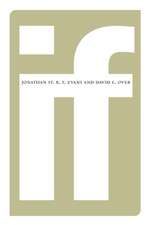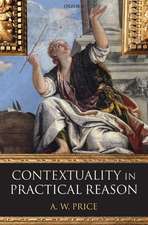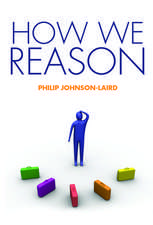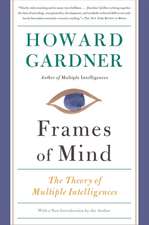Paradoxes of Culture and Globalization
Autor Martin J. Gannonen Limba Engleză Paperback – 4 sep 2007
| Toate formatele și edițiile | Preț | Express |
|---|---|---|
| Paperback (1) | 554.96 lei 6-8 săpt. | |
| SAGE Publications – 4 sep 2007 | 554.96 lei 6-8 săpt. | |
| Hardback (1) | 829.26 lei 6-8 săpt. | |
| SAGE Publications – 4 sep 2007 | 829.26 lei 6-8 săpt. |
Preț: 554.96 lei
Preț vechi: 652.89 lei
-15% Nou
106.23€ • 115.42$ • 89.29£
Carte tipărită la comandă
Livrare economică 21 aprilie-05 mai
Specificații
ISBN-10: 1412940451
Pagini: 288
Dimensiuni: 152 x 229 x 15 mm
Greutate: 0.4 kg
Ediția:1
Editura: SAGE Publications
Colecția Sage Publications, Inc
Locul publicării:Thousand Oaks, United States
Recenzii
"This is a very engaging read filled with real-life examples that both academics and practitioners will readily enjoy, and it introduces theory so deftly and in such a down-to-earth manner that even undergraduate students won’t realize that they are learning communication theory."
Cuprins
1.1 PARADOXES, EDUCATION AND TRAINING
1.2 EXERCISE: INTRODUCING THE BOOK
1.3 A NOTE ON WRITING
1.4 ACKNOWLEDGEMENTS
PART 1: CONCEPTUAL FOUNDATIONS
CHAPTER 1: THINKING PARADOXICALLY
1.1 ESSENTIAL CONCEPTS
1.2 LIMITATIONS
1.3 TAKEAWAYS
1.4 DISCUSSION QUESTIONS
1.5 EXERCISES
CHAPTER 2: CONCEPTUALIZING AND PERCEIVING CULTURE
2.1 CONCEPTUALIZING CULTURE
Paradox 2.1 Why are there so many definitions of culture?
Paradox 2.2 Can there be a very large and a very small number of cultures?
Paradox 2.3 Can collectivists be self-centered and selfish?
Paradox 2.4 Value paradoxes exist in all cultures. For example, how can a national culture value freedom and dependence simultaneously?
Paradox 2.5 How are cultural values and cultural practices related?
Paradox 2.6 Does culture matter?
Paradox 2.7 Are demographics more important than culture?
Paradox 2.8 Should we advocate only one perspective on culture?
2.2 PERCEIVING CULTURE
Paradox 2.9 Do proper introductions and greetings simultaneously involve kissing, bowing, and shaking hands?
Paradox 2.10 Are cultural stereotypes valid?
Paradox 2.11 Are the distinctions between levels of culture relevant in a globalizing world?
Paradox 2.12 Do insiders understand their own cultures better than outsiders?
Paradox 2.13 Can global citizenship and the effects of root cultures exist simultaneously?
Paradox 2.14 Can cultures change quickly?
2.3 TAKEAWAYS
2.4 DISCUSSION QUESTIONS
2.5 EXERCISE: CHAPTER 1
2.6 EXERCISE AFTER EACH CHAPTER
PART 2: BEHAVIORAL ISSUES
CHAPTER 3: LEADERSHIP, MOTIVATION, AND GROUP BEHAVIOR ACROSS CULTURES
Paradox 3.1. Framing leadership: Is the essence of leadership being stuck on the horns of a dilemma?
Paradox 3.2 Who is more effective: The instrumental/visionary/transformational leader or the Headman?
Paradox 3.3 When should a leader involve subordinates in decision making?
Paradox 3.4 Can an effective leader be someone who publicly humiliates subordinates?
3.2 MOTIVATION
Paradox 3.5 Is the relationship between motivation and ability additive or multiplicative in the prediction of individual success and performance?
Paradox 3.6 Can an individually-based need hierarchy exist in a collectivistic culture?
Paradox 3.7 Do effective executives attribute success to themselves or to others?
3.3 GROUP BEHAVIOR
Paradox 3.8 Are there free riders or equally-responsible contributors in small groups?
Paradox 3.9 Do the personalities of individuals primarily reflect the influence of culture both in general and in small groups?
Paradox 3.10 Should multi-cultural groups be managed differently than single-culture groups?
3.4 TAKEAWAYS
3.5 DISCUSSION QUESTIONS
3.6 EXERCISES
3.7 ANSWERS
CHAPTER 4: COMMUNICATING ACROSS CULTURES
4.1: LANGUAGE
Paradox 4.1 How can knowing the language of another culture be a disadvantage?
Paradox 4.2 How can languages be rapidly dying while becoming more influential?
Paradox 4.3 Critical words and phrases: How can there be immediate recognition by
Paradox 4.4 Are proverbs effective descriptors of a culture?
4.2 CONTEXT AND BEYOND
Paradox 4.5 Can a culture be simultaneously monochronic and polychronic?
Paradox 4.6 Can a culture be simultaneously low-context and high-context?
4.3 SYMBOLISM
Paradox 4.5 Can a culture be simultaneously monochronic and polychronic?
Paradox 4.6 Can a culture be simultaneously low-context and high-context?
4.3 SYMBOLISM
Paradox 4.7 How can the same phenomenon represent different symbolic meanings?
Paradox 4.8 How can the same phenomenon represent different symbolic meanings?
4.4 TECHNOLOGY AND MEDIATED COMMUNICATION
Paradox 4.9 Can face-to-face communication be functionally equivalent to mediated communication, either individually or in small groups?
Paradox 4.10 Is the Internet integrating the world or creating wide differences?
Paradox 4.11 Is colonization or communitarianism winning in the battle for the Internet?
Paradox 4.12 Why is the information superhighway a poor metaphor for describing modern communication systems such as the Internet?
4.5 TAKEAWAYS
4.6 DISCUSSION QUESTIONS
4.7 EXERCISE (CRITICAL INCIDENT)
CHAPTER 5: CROSSING CULTURES
5.1 CULTURE-BASED ETHICS: RELATIVISM VERSUS UNIVERSALISM
Paradox 5.1 Are ethical norms and standards universal or relative to the situation?
5.2 GENERIC CULTURES AND ETHICS
Paradox 5.2 Are there universal ethics across generic cultures, or do ethics vary by the type of generic culture?
5.3 EXPATRIATE PARADOXES
Paradox 5.3 Is the general stereotype of the host culture valid?
Paradox 5.4 How can the Expat manager be simultaneously powerful and powerless?
Paradox 5.5 How can the Expat manager be simultaneously free of home country norms and restrained by host country norms?
Paradox 5.6 How can the Expat manager simultaneously accept the ideal cultural values of the home culture and realize that they do not exist in the home culture or only in attenuated form?
Paradox 5.7 How can the Expat manager resolve the conflict between contradictory demands of the home office and the host culture subsidiary?
Paradox 5.8 How can the Expat manager simultaneously give up some home country values and strengthen other home country values?
Paradox 5.9 Is it possible for the Expat manager to become more cosmopolitan and more idiosyncratic simultaneously?
Paradox 5.10 How can the Expat manager think well of the host culture and avoid being taken advantage of?
Paradox 5.11 How can the Expat manager be simultaneously at home anywhere in the world but fit comfortably nowhere?
5.4 UNDERSTANDING CROSS-CULTURAL INTERACTIONS VIA CULTURAL SENSEMAKING
5.5 REENTRY TO THE HOME CULTURE
5.6 TAKEAWAYS
5.7 DISCUSSION QUESTIONS
5.8 EXERCISES
5.9 ANSWERS TO THE TWO-ITEM SURVEY
CHAPTER 6: CROSS-CULTURAL NEGOTIATIONS
6.1 FUNDAMENTALS AND BEST PRACTICES
6.2 CASE STUDY: ENTERING THE CHINESE MARKET
6.3 NEGOTIATING METAPHORS
Paradox 6.1 Is chess more influential than the Chinese board game of Go for strategy and negotiation?
Paradox 6.2 Why do veteran international negotiators from one national culture frequently complain that their counterparts from a dissimilar national culture are simultaneously both very sincere and very deceptive?
Paradox 6.3 When negotiating, is it best to make the opening offer or respond to it?
6.4 TIME, FACE, AND THE YINYANG DYNAMIC
Paradox 6.4 How can time be considered as three circles (past, present, and future) as well as only one circle?
Paradox 6.5 Is the yinyang dynamic exclusively Asian?
Paradox 6.6 Is there only one type of face?
6.5 TAKEAWAYS
6.6 DISCUSSION QUESTIONS
6.7 CASE STUDY: GENERATOR AND ITS ASIAN PARTNERS
PART 3: THE BROADER CONTEXT
CHAPTER 7: MULTI-ETHNICITY, RELIGION, GEOGRAPHY, AND IMMIGRATION
7.1 MULTI-ETHNICITY
Paradox 7.1 Do multi-ethnic groups impede or facilitate the formation of national cultures?
Paradox 7.2 Is there, or will there be, a clash of civilizations?
Paradox 7.3 Can national cultures exist in a multi-ethnic and borderless world?
Paradox 7.4 Should all cultural practices be equally acceptable?
7.2 RELIGION
Paradox 7.5 Must religion be anthropomorphic?
Paradox 7.6 Does a religion necessarily require dogmas and creeds?
7.3 GEOGRAPHY
Paradox 7.7 Do geographic maps reflect cultural beliefs?
Paradox 7.8 Has “the death of distance” nullified the importance of geography?
7.4 IMMIGRATION
Paradox 7.9 Will the issue of immigration derail globalization?
Paradox 7.10 How can restricting immigration facilitate and promote it?
Paradox 7.11 Is immigration compatible with an equality matching culture?
7.5 TAKEAWAYS
7.6 DISCUSSION QUESTIONS
7.7 EXERCISES
CHAPTER 8: ECONOMIC DEVELOPMENT AND CULTURE
8.1 BACKGROUND
8.2 TRADE, DEMOCRACY, AND OPEN AND FREE MARKETS
Paradox 8.1 Are democracy and free markets opposed to one another?
Paradox 8.2 Does trust increase trade among nations? Does increased trade lead to conflict and war among nations?
8.3 CULTURE AND CHANGE
Paradox 8.3 Are institutions more important than culture for explaining economic development?
Paradox 8.4 Does economic development and globalization lead to individualism?
Paradox 8.5 Why do citizens vote for and accept stationary bandits as political leaders?
8.4 TAKEAWAYS
8.5 DISCUSSION QUESTIONS
8.6 EXERCISE
CHAPTER 9: GLOBALIZATION AND CULTURE
9.1 RISK
Paradox 9.1 Can global economic integration occur without political and cultural integration?
Paradox 9.2 Is globalization a myth?
Paradox 9.3 Is globalization an old or a new phenomenon?
9.2 UNCERTAINTY
Paradox 9.4 Is there a reasonable probability that a global financial collapse will occur and undermine globalization?
Paradox 9.5 Does globalization encourage nationalism?
Paradox 9.6 Are nations becoming more and less powerful simultaneously because of globalization?
Paradox 9.7 Can one nation dominate the global economy and political system?
Paradox 9.8 Is globalization doomed?
9.3 POLITICAL AND SOCIAL ISSUES
Paradox 9.8 Does globalization increase prosperity and inequality simultaneously?
Paradox 9.9 Who are the winners and losers in a globalizing world?
Paradox 9.10 Is increased education the anti-dote for outsourcing?
9.4 TAKEAWAYS
9.5 DISCUSSION QUESTIONS
9.6 EXERCISES
CHAPTER 10: STRATEGY, BUSINESS FUNCTIONS, AND INTERNATIONAL HUMAN RESOURCE MANAGEMENT
10.1 STRATEGY
Paradox 10.1 Is there an ideal mode for entering the global marketplace?
Paradox 10.2 Is there an ideal structure for the global firm?
Paradox 10.3 Are organizations worldwide becoming more similar?
Paradox 10.4 Is China a very large or a very small market?
10.2 BUSINESS FUNCTIONS
Paradox 10.5 Can accounting and financial systems be standardized or harmonized throughout the world?
Paradox 10. Should global advertising be tailored to each national and ethnic culture?
Paradox 10.7 Is it possible to create and operate airplane-based metropoli (the aeropolis) for efficient global logistics and transportation?
10.3 INTERNATIONAL HUMAN RESOURCE MANAGEMENT
Paradox 10.8 How can IHRM be both central and peripheral when going global?
Paradox 10.9 How should the conflict between internal pay equity and the forces of the external marketplace be resolved?
Paradox 10.10 Should multi-national corporations impose their values when going global?
Paradox 10.11 Which works best in a global firm, individual-based or group-based reward systems?
Paradox 10.12 Is the role of IHRM different from that of domestic-only HRM?
Paradox 10.13 Are HRM requirements similar throughout the globalizing world?
10.3 TAKEAWAYS
10.4 DISCUSSION QUESTIONS
10.5 EXERCISE
References
Notă biografică
Martin J. Gannon (Ph.D., Graduate School of Business, Columbia University) is Professor Emeritus of Strategy and International Management at both the Smith School of Business, University of Maryland at College Park and the College of Business Administration, California State University San Marcos. He is a three-time recipient of the Fulbright Professorship Award (West Germany, 1981-82; Thailand, 1987; and Austria, 2017-18).
His other awards include: 1) The Outstanding Educator Award, International Division, 2014, Academy of Management, the largest and best known management and teaching organization in the world; 2) the University of Maryland¿s International Landmark Award for his contributions in the global area, 2003; and 3) the Lifetime Achievement Award, Whös Who in America, 2018. See below for additional awards.
Professor Gannon has been a Senior Research Fulbright Fellow in West Germany; the John F. Kennedy Foundation/Fulbright Professor at Thammasat University, Bangkok, Thailand; and the Fulbright Professor, Johannes Kepler University, Austria. He has also been a visiting professor at the London Business School, Bocconi University (Italy), University College - Dublin, the University of Lodz (Poland), Wuhan University, Chulalongkorn University (Bangkok), and the University of Kassel and Tubingen University in Germany, and has lectured at many other universities in the world.
At the Smith School of Business he served as the Acting Associate Dean for Academic Affairs, Founding Director of the Center for Global Business, Chairperson of the Faculty of Management and Organization, Co-founder and Co-director of the Small Business Development Center, and the Founding Director of the College Park Scholars Program in Business, Society, and the Economy (an undergraduate living-learning community). He is the author of over 100 articles and papers as well as 13 books, some in multiple editions and translations (Korean, Spanish, and Italian). He recently completed a draft of his 20th book. See below.
Professor Gannon has emphasized three overlapping areas of programmatic or in-depth research: International management and behavior; business strategy; and the contingent workforce, particularly studies of temporary help employment. Much of his work in international management and behavior is described in depth in the book, Understanding Global Cultures: Metaphorical Journeys Through 31Nations, Clusters of Nations, Continents, and Diversity, 5th Edition (Sage, May, 2012, c. 2013, 639 pages; Korean translation, Myung In Publishers, 2013). Rajnandini Pillai joined him as co-author after the 3rd edition. The 6th edition was published in 2016 and includes 34 national cultures and their corresponding 34 cultural metaphors. Although the publisher wanted a 7th edition, Professor Gannon decided to pursue other writing opportunities.
In this book Gannon introduced the concept of the cultural metaphor to describe the culture of a specific nation. He defines a cultural metaphor as any institution, phenomenon or activity with which a nation¿s citizens identify emotionally and/or cognitively, for example, the Swedish stuga or unadorned summer and weekend home. He then uses these metaphors and their distinctive features as frameworks to describe in depth the values and the associated business activities in each nation. The 6th and latest edition is divided into a fourteen-part framework to classify these 34 nations and their respective cultural metaphors, clusters of nations, continents, and diversity within nations into different types, e.g., authority ranking and market pricing national cultures as separate parts.
In 2018 he was the senior author of a unique study of 28 cross-cultural experts. The goal was the analysis of the relative advantages and disadvantages of the three most popular methods of comparing and contrasting national cultures: The dimensional perspective as represented by Geert Hofstede and other cross-cultural analysts; the cultural metaphor; and the cultural paradoxical approach. See the publications below for this and other references.
He recently completed a draft of his 20th book, A Memoir of Management Insights: The Strategic Realistic Method for Life and Career Success. It combines three separate perspectives: A memoir; the management insights that the author has achieved through his many and varied activities; and a career or self-help book. As in the case of his other books, this one is unique. It is currently with an agent, who plans to submit it to 12 major publishers.
In the area of contingent employment, he has written many articles that have appeared in such journals as The Academy of Management Review, the Journal of Applied Psychology, and Industrial Relations. He is also the senior co-author of "Managing Without A Complete, Full-Time Workforce," that appeared in Flood, Gannon, Pauuwe, and Associates, Managing Without Traditional Methods: International Innovations in Human Resource Management (Addison-Wesley, 1996).
In the area of business strategy, he is the co-author of the Dynamics of Competitive Strategy (Sage, 1992), in which the authors develop a unique communication-information model of competitive interaction among firms in an industry, describe new methods for analyzing competitive moves and responses, and test hypotheses about such competitive interactions in four major industries. Mr. Gannon is also the co-author of Strategic Management Skills (Addison-Wesley, 1986), which was a pioneering effort to train MBA students and managers in strategic case analysis and written and oral presentation skills. In 2008 Ofer Meilich and Martin Gannon published an article, ¿Redefining Value: Comparative Video Case Studies of Charles Shaw Winery and Thomas Kincade,¿ in the Journal of Strategic Management Education.
As indicated above, Mr. Gannon¿s research and writing have appeared in over 100 articles and papers. Journals in which he has published include the Academy of Management Journal, The Academy of Management Review, Journal of Applied Psychology, Personnel Psychology, Industrial Relations, Monthly Labor Review, California Management Review, Business Horizons, Journal of Business Research, Journal of Business Venturing, International Journal of Management, International Journal of Intercultural Relations, Business & the Contemporary World, and the Journal of Accountancy.
Further, Professor Gannon has published several textbooks, including Management: Managing for Results (Allyn and Bacon, 1988, Spanish translation, 1996); Management: an Organizational Framework (Little, Brown and Co., 1977, and reprinted in a special edition of 10,000 copies by the Life Insurance Institute of America; second edition of this book, 1982); and Organizational Behavior (Little, Brown and Co., 1979). His organizational framework of management was incorporated into the Introduction to Management course at the Army War College for many years.
Professor Gannon has taught a range of courses over a 50-year period for managers, MBA students, EMBA students, undergraduates, and doctoral students. Currently he enjoys teaching Managing in Different Cultures; Cross-Cultural Negotiations; and Strategic Management.
Professor Gannon has served as a consultant and trainer to a large number of organizations, including Chemical Bank of New York, the U.S. General Accounting Office, U.S. Office of Personnel Management, the Upjohn Company, the American Federation of Government Employees, ARINC, Northrop-Grumman and GEICO Insurance. At GEICO he was the only external consultant on the design and presentation of the annual week-long Senior Management Training Program for ten years from which those promoted to Director and above were selected.. At Northrop-Grumman he served as the University of Maryland Academic Director of the IMPACT Training Program (International Management Program and Compliance Training), an internal certificate program required for advancement to international management positions. In 2008 he received a Career Contribution Award from GEICO. Professor Gannon has served on and chaired numerous committees in universities and professional/academic associations. He has lived and lectured in over 30 nations for various periods of time extending from one week to a year or more.















